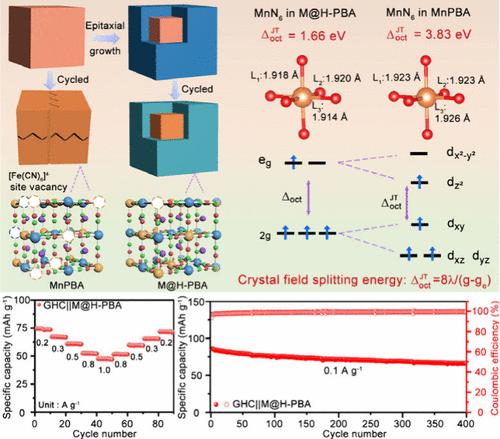在mn基普鲁士蓝模拟物上生长用于na离子存储的高熵层
IF 18.2
1区 材料科学
Q1 CHEMISTRY, PHYSICAL
引用次数: 0
摘要
锰基普鲁士蓝类似物(MnPBAs)由于其比容量而被用作钠离子电池的阴极。然而,它们的实际应用受到低电子/离子电导率和Jahn-Teller效应的限制,导致其速率性能和循环稳定性较差。在此,我们提出了一种具有高熵涂层的核壳MnPBA阴极,通过外延生长策略来解决上述问题。由于协同鸡尾酒效应和缓冲功能,高熵PBA (HEPBA)作为导电保护层,促进离子电导率,抑制MnPBA内部的Jahn-Teller畸变。因此,得到的MnPBA@HEPBA (M@H-PBA)阴极既继承了核的容量贡献,又继承了壳的结构稳定性。具体来说,M@H-PBA在1 A g-1下进行1000次循环后可提供81.8%的容量保留。与葡萄糖衍生的硬碳(GHC)结合,在0.1 A g-1下循环400次后,GHC∥M@H-PBA全电池的比容量保持在80.0%左右。本文章由计算机程序翻译,如有差异,请以英文原文为准。

High-Entropy Layer Grown on Mn-Based Prussian Blue Analog for Na-Ion Storage
Mn-based Prussian blue analogs (MnPBAs) are used as cathodes for Na-ion batteries because of their specific capacity. However, their practical application is limited by low electron/ionic conductivity and the Jahn–Teller effect, which lead to poor rate performance and cycle stability. Herein, we propose a core–shell MnPBA cathode with a high-entropy coating layer through an epitaxial growth strategy to address the above issues. Owing to the synergistic cocktail effect and the buffering function, the high-entropy PBA (HEPBA) serves as a conductive and protective layer to promote ionic conductivity and inhibit the Jahn–Teller distortion from inner MnPBA. Therefore, the obtained MnPBA@HEPBA (M@H-PBA) cathode inherits the capacity contribution of the core and the structural stability of the shell. Specifically, M@H-PBA delivers 81.8% capacity retention after 1000 cycles at 1 A g–1. Combined with glucose-derived hard carbon (GHC), the specific capacity of the GHC∥M@H-PBA full cell retains about 80.0% after 400 cycles at 0.1 A g–1.
求助全文
通过发布文献求助,成功后即可免费获取论文全文。
去求助
来源期刊

ACS Energy Letters
Energy-Renewable Energy, Sustainability and the Environment
CiteScore
31.20
自引率
5.00%
发文量
469
审稿时长
1 months
期刊介绍:
ACS Energy Letters is a monthly journal that publishes papers reporting new scientific advances in energy research. The journal focuses on topics that are of interest to scientists working in the fundamental and applied sciences. Rapid publication is a central criterion for acceptance, and the journal is known for its quick publication times, with an average of 4-6 weeks from submission to web publication in As Soon As Publishable format.
ACS Energy Letters is ranked as the number one journal in the Web of Science Electrochemistry category. It also ranks within the top 10 journals for Physical Chemistry, Energy & Fuels, and Nanoscience & Nanotechnology.
The journal offers several types of articles, including Letters, Energy Express, Perspectives, Reviews, Editorials, Viewpoints and Energy Focus. Additionally, authors have the option to submit videos that summarize or support the information presented in a Perspective or Review article, which can be highlighted on the journal's website. ACS Energy Letters is abstracted and indexed in Chemical Abstracts Service/SciFinder, EBSCO-summon, PubMed, Web of Science, Scopus and Portico.
 求助内容:
求助内容: 应助结果提醒方式:
应助结果提醒方式:


